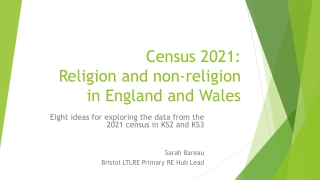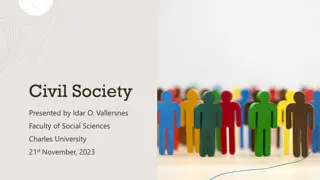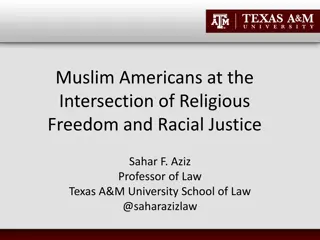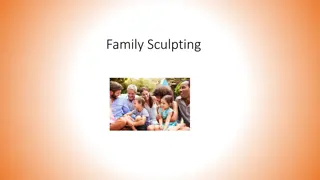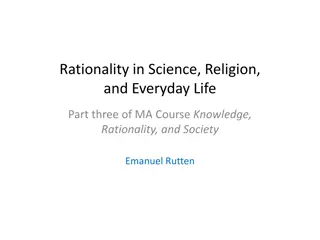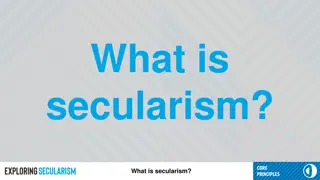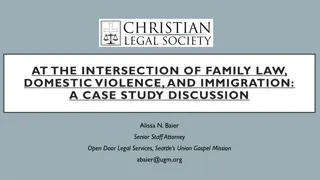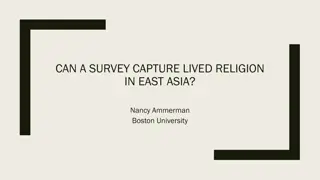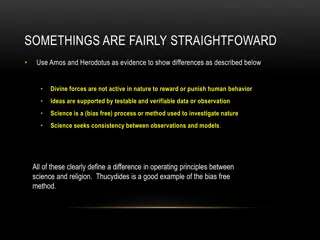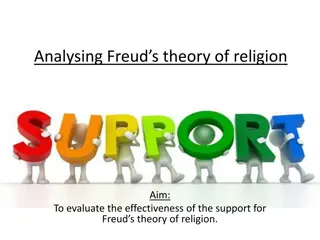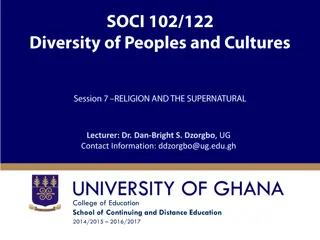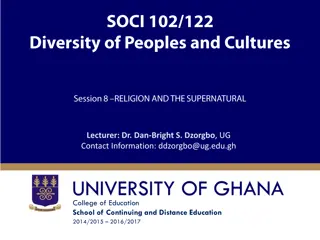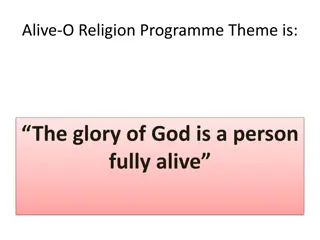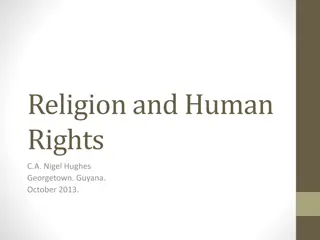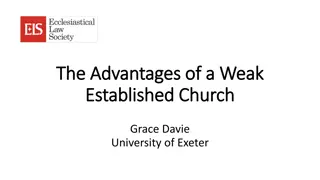Understanding the Intersection of Religion, Family, and Society
Explore the sociological perspective on religion and family dynamics. Religion encompasses a set of beliefs and practices centered around sacred phenomena, shaping social norms and offering meaning. Religious affiliations, beliefs, and attendance reflect individual and collective values. Conservative and liberal faith traditions influence family arrangements, emphasizing adherence to tradition and sacred covenants. Delve into how religion impacts dating and relationship formation.
Uploaded on Sep 12, 2024 | 0 Views
Download Presentation

Please find below an Image/Link to download the presentation.
The content on the website is provided AS IS for your information and personal use only. It may not be sold, licensed, or shared on other websites without obtaining consent from the author. Download presentation by click this link. If you encounter any issues during the download, it is possible that the publisher has removed the file from their server.
E N D
Presentation Transcript
RELIGION AND FAMILY A Sociological Perspective
WHAT IS RELIGION? Dimensions of religion Set of beliefs and practices oriented toward sacred phenomena Beliefs are views, perceptions, and outlooks (e.g., belief in God, views of scripture) Practices are behaviors or actions (e.g., worship, prayer, scripture study) Religion is a social phenomenon Rituals are often performed collectively and are governed by social norms As an institution, religion offers meaning, belonging, and social control Even individual devotion (personal prayer or scripture study) is socially learned Persistence of religion U.S. is a highly religious nation despite some increase in secularism among young people Religion maintains a significant social role in the contemporary world
WHAT IS RELIGION? Conceptualization of religion Affiliation: Connection to a faith tradition, denomination, or sect Faith traditions include Christianity, Judaism, Islam, Buddhism, Hinduism, etc. Christian denominations include Catholic, Southern Baptist (conservative Protestant), Episcopalian (mainline Protestant), Church of God in Christ (Black Pentecostal), etc. Variants of Judaism (Orthodox, Reformed) and Islam (Sunni, Shia) Religious beliefs Belief in God (theism, degree of certainty), images of God (judging vs. loving), afterlife (heaven, hell, etc.), scripture (literal vs. metaphorical); beliefs often shaped by affiliation Religious attendance Most often examined as attendance at worship services (religious network integration) Other facets of involvement include youth group, congregational programs, etc.
RELIGION, PARTNERING, AND FAMILY FORMATION
KEY PATTERN: CONSERVATIVE VS. LIBERAL FAITHS In general, theologically conservative faith traditions are more supportive of traditional family arrangements than liberal faiths Family beliefs and practices evident among members of liberal faith traditions are often indistinguishable from the religiously unaffiliated Conservative faith traditions are often critical of mainstream views and behaviors related to family life Conservative traditions often stress adherence to tradition as articulated in sacred scripture Overall, conservative faith traditions tend to discourage premarital sex and cohabitation while promoting marriage, which is viewed as a sacred covenant
DATING Dating is a culturally informed pattern for forming romantic relationships and ultimately selecting a mate (partner) Some young people today are less apt to date, more inclined to hang out Religious differences in dating and romantic relationship formation Most of this research has focused on Christian traditions In the U.S., non-Christian groups typically do not have sufficient numbers to generate meaningful statistical comparisons in national surveys Conservative faiths exhibit mixed views of dating Concerns about such activity providing opportunities for premarital sex, considered sin Latter-day Saints (Mormons) place restrictions on dating: No dating until age 16 Dating seen as acceptable pathway to marriage in some circumstances (group dates)
SEXUAL ACTIVITY AND HOOKING UP Sexual activity tends to be delayed among members of theologically conservative faith traditions Latter-day Saints (LDS/Mormons) stress chastity, which is institutionally tied to temple worship for young people and temple marriage for young adults Thus, prolonged virginity is most pronounced among LDS young people, somewhat evident among conservative Protestants ( True Love Waits ) There are also religious variations in hooking up Hooking up is less common among conservative Protestant young women in college than their unaffiliated (non-religious) peers Hooking up is more common among Catholic college-attending women than their non- religious counterparts Nevertheless, regular attendance reduces hooking up among college women
COHABITATION AND MARRIAGE Similar patterns are evident concerning religion, cohabitation, and the timing of first marriage Conservative faith traditions discourage cohabitation and, for the most part, active members who are affiliated with these traditions and regularly attend are less likely to cohabit prior to marriage More opposition to same-sex marriage is evident among conservative faiths Not surprisingly, these same groups tend to marry at an earlier age Latter-day Saints (LDS/Mormons) tend to marry at the earliest age, followed by conservative Protestants There is not much difference between Catholics, mainline Protestants, and those who are unaffiliated; all these embrace mainstream delay of marriage
QUESTIONS FOR DISCUSSION AND ONGOING INQUIRY Some religious groups, particularly conservative ones, argue that sexual activity should be reserved for marriage. Examine websites that describe how conservative Protestant, Latter-day Saint, and Orthodox Jewish faiths view sexual activity. How do these views differ from mainstream secular views of sexual activity? Some religious groups have been affected by debate and dissent concerning same-sex marriage. Choose a faith tradition that has an official policy on whether or not their religious leaders are permitted to perform same-sex marriages. Describe the policy and its underlying rationale (justification).
RELIGION, RELATIONSHIP QUALITY, PATERNAL INVOLVEMENT, AND HOUSEWORK
RELIGIOUS HOMOGAMY AND HETEROGAMY It is important to think about religion not solely as an individual attribute; it is also a group property Within the context of marriage, same-faith marriages (homogamy) can be distinguished from mixed-faith marriages (heterogamy) Mixed-faith marriages have become increasingly prevalent in the latter part of the twentieth century and into the twenty-first century This pattern is interpreted by some researchers as evidence of secularization, yet this point is debated among scholars; the issue is complex It is possible that religion still influences family life but that the religious background of one s mate has diminished in influence
RELIGION AND RELATIONSHIP QUALITY Many family scholars study the quality of people s intimate relationships (cohabiting partnerships, marriages) Religion has been shown to influence marital quality positively Moreover, couples in same-faith marriages report higher marital quality than couples in mixed-faith marriages or unaffiliated couples Same-faith marriages exhibit higher levels of marital quality because of the shared worldviews of couples from the same religious background, and religious groups definition of family as sacred Shared religious values create a common frame of reference
RELIGION, MARITAL CONFLICT, AND DOMESTIC VIOLENCE Other facets of religious marriages are intriguing as well Consistent with the research on marital quality, relationships among spouses from the same faith background exhibit less conflict than those among mixed-faith couples Here again, religious homogamy is an advantage while heterogamy can be a disadvantage Domestic violence is not more common among theologically conservative couples despite these groups traditional gender views Still, theologically conservative men are more likely to abuse their theologically liberal wives; thus, specific religious combinations are important
RELIGION AND PATERNAL INVOLVEMENT American fathers are less involved with children than mothers These disparities reflect broader societal patterns in gender Child care is feminized (viewed as or assumed to be women s work ) Child care not rewarded vs. workplace success and public achievements Conservative Protestant fathers are more involved with their children (e.g., having regular family meals, monitoring children s behavior) Fatherhood in these faith communities is defined as active involvement Patriarchal language (father as head or leader ) encourages involvement Leadership defined as presence and participation, not ruler or dictator
RELIGION AND HOUSEWORK Housework in American families is gendered, with women investing considerably more time in housework than men These disparities again reflect broader gender norms in the general population Housework is devalued relative to paid labor force participation Housework investments are less unequal in dual-earner couples Housework among conservative Protestant dual-earner couples is quite unequal Conservative Protestant wives/mothers invest more time in household tasks Such disparities are magnified for women s tasks (laundry, meal prep) Traditional gender norms in such families influence these disparities
QUESTIONS FOR DISCUSSION AND ONGOING INQUIRY Conservative Protestant families show an odd mix of gender traditionalism and gender progressivism. Housework in such families tends to be less equally divided. However, fathers in such homes are more involved in the lives of their children. How might these apparently contradictory patterns be explained? There are not many statistical differences observed between Catholic, mainline Protestant, and secular families in terms of housework and paternal involvement. What does this lack of difference tell us about such families? Might other methodological approaches to studying these families yield new insights that statistics miss?
ASSIGNMENT OPPORTUNITY As a class, develop an interview questionnaire designed to examine married couples appraisals of their relationships, including meaningful shared experiences, most and least favorite activities, efforts to overcome challenges they have encountered, etc. 1. Split the class in half. Charge half with interviewing spouses in highly religious same-faith marriages. Assign the other half with interviewing spouses in non- religious (secular) marriages. 2. Each student must interview each partner in a one couple relationship separately. Transcribe and analyze those two interviews. 3. Students compare their findings in a class discussion of the results. 4.
RELIGION, PARENTING, AND CHILD DEVELOPMENT
RELIGION AND FERTILITY (CHILDBEARING) Consider the data presented in the following table. https://www.pewforum.org/2015/05/12/chapter-3-demographic-profiles-of- religious-groups/pr_15-05-12_rls_chapter3-07/ What patterns are evident in this table concerning religious differences in completed fertility? What patterns are evident concerning children currently at home? How can broad differences between all of the religious groups (in general) and the nonreligious groups be explained? Finally, how can specific differences among the various religious groups be explained?
RELIGION AND PARENTING There are significant religious variations in parenting attitudes and practices Conservative Protestants express more supportive attitudes toward physical discipline (corporal punishment, spanking) Conservative Protestant parents are more inclined to use corporal punishment to discipline their children Leading conservative Protestants encourage the use of physical discipline when children defy parental authority Biblical interpretations are used to support this practice
RELIGION AND PARENTING However, conservative Protestant parents are not harsh authoritarians Although conservative Protestant parents more commonly spank their children, they are also more inclined to hug and praise their kids than other parents These same parents are also less likely to yell at their children This odd mix of childrearing practices has been described as a parenting paradox because they are not often used in tandem Biblical interpretations also support parent-child love
RELIGION AND PARENTING Interestingly, the effects of conservative Protestant child discipline are different than those in other families While corporal punishment has been associated with negative effects on children in the population at large, these same patterns are not evident in conservative Protestant homes Why do conservative Protestant families deviate from this pattern? Cultural values and beliefs in a community are powerful: Conservative Protestants define corporal punishment as a parental demonstration of concern for the welfare of children Situations defined as real are real in their consequences -- W.I. Thomas
RELIGION AND CHILD SEXUAL ABUSE Recent media reports have highlighted the disturbing prevalence of child sexual abuse by religious leaders This problem is especially widespread in the Catholic Church s decades-long cover-up Research has only begun to examine this issue Negative consequences for children abused by clergy Mental health trauma and religious identity difficulties Lay Catholics have mobilized to lobby for changes (Survivors Network of those Abused by Priests SNAP) Discussion question: What actions do you think should be taken to address this problem and prevent it in the future?
RELIGION, FAMILY, AND CHILD DEVELOPMENT For quite some time, the effects of religion on child development were not examined (lack of data, likely fed by academic secularism) Recent evidence indicates that religion can provide a positive developmental platform for children s growth Religion can enhance children s social skills, foster psychological adjustment Faith communities sanctify parent-child relationships, provide role models There are also potential downsides Parental arguments about religion can harm children s development Children s exposure to religion can undermine their performance on standardized math and science tests
ASSIGNMENT OPPORTUNITY Read the following study on religion and child development. https://doi.org/10.3390/rel10010037 1. What does this study reveal concerning the effects of religion on child development? What findings stand out to you? 2. What questions is this study unable to answer? Consider the ways in which religion and child development are measured (and not measured), as well as the sole reliance on statistical data. 3. If you had to design a study on the role of religion in the lives of young children, what approach would you use to investigate this issue? Why would you adopt that approach? 4.
RELIGION, DIVORCE, AND REMARRIAGE
RELIGION, DIVORCE, AND REMARRIAGE Leaders of various faith traditions (Catholic, conservative Protestant, Mormon, and Orthodox Jewish) have spoken out against divorce Conservative Protestants exhibit quite negative attitudes toward divorce Yet, as divorce has become more common in society at large, divorce rates in faith communities have increased as well Same-faith couples are less likely to divorce than mixed-faith couples How can this pattern be explained? The vast majority of people who divorce will, at some point, remarry Conservative Protestants tend to remarry more quickly than others Catholics are slow to remarry due to institutional barriers to remarriage
RELIGION AND FAMILY IN GLOBAL CONTEXT
RESEARCH ON RELIGION AND FAMILY WORLDWIDE Research discussed thus far has focused on the U.S. context Yet, religion is a powerful social force around the world What do we know about religious families in other social contexts? Original research is scarce compared with that focused on U.S. families Yet, there is evidence of a strong relationship between religion and family life around the world Global expressions of the religion-family relationship are remarkably diverse Why? Global religions themselves exhibit breathtaking variation
RELIGION AND FAMILY WORLDWIDE: JEWISH FAMILIES There are several variants of Judaism Orthodox Judaism Traditional Jewish practices and lifestyles Modern Orthodox Judaism is more welcoming of the larger secular society Ultra-Orthodox Judaism tends to limit the degree of interaction with secular culture; highly traditional Reform Judaism Views traditional Jewish beliefs and practices as somewhat outdated Defined by nationalities (German, French, etc.); sees Judaism as a religion, not a primary identity Called Liberal Judaism or Progressive Judaism in Europe; called Neolog Judaism in Hungary Conservative Judaism The middle ground between Orthodox Judaism and Reform Judaism Preserves Jewish traditions, but exhibits measured openness to modern social life Many people practice Judaism in ways that differ from these primary variants Some combine aspects from each branch; Jewish practice best understood as a spectrum
RELIGION AND FAMILY WORLDWIDE: JEWISH FAMILIES As Jewish communities integrated with secular society, practices that were traditionally under the rule of Jewish law came under the jurisdiction of civil law This dual authority created tension concerning marriage and family Reform Judaism accepted the legal processes of both entering and exiting marriages as outlined by civil law However, Orthodox Judaism and Conservative Judaism resisted acceptance of divorce, given that the secular society did not account for (or require) a religious separation For Orthodox and Conservative Judaism, a civil divorce without religious consideration would render any additional marriages as illegitimate and adulterous Orthodox Judaism advocated a prenuptial agreement that requires a husband to support his wife financially until there is a formal religious divorce Conservative Judaism developed the ketubah (Jewish marriage contract) Video on Ketubah: https://youtu.be/clM1SEJfixo
RELIGION AND FAMILY WORLDWIDE: JEWISH FAMILIES In some traditional Jewish families, a husband and wife abstain from conjugal relations (sexual activity with one another) during niddah Niddah is a phase that begins with the start of a woman s menstrual cycle and lasts about twelve days, with the exact number of days varying among different Jewish branches Jewish mikvah A mikvah is the ceremonial immersion of Jewish women in a pool of water In traditional Judaism, niddah officially ends when a woman is immersed into the mikvah and becomes pure again This practice is not found in Reformed Judaism Many modern Jewish branches have broadened the usage of the mikvah https://youtu.be/PGfvqBl-3Ao https://www.myjewishlearning.com/article/the-mikveh/
RELIGION AND FAMILY WORLDWIDE: JEWISH FAMILIES Globally, Israel s rise as a Jewish state has reinforced Jewish identity Prior to the establishment of Israel, Jews did not have a clearly defined homeland Israel further increased the world prominence of Judaism Child-rearing in Israel In Israel, the majority of children are raised in nuclear families, similar to the dominant family form found in the U.S. But there is also a long tradition of communal living in Jewish societies that features a collective approach to child-rearing in kibbutzim https://www.jewishvirtuallibrary.org/history-and-overview-of-the-kibbutz-movement https://www.youtube.com/watch?v=W5_JO8-zRZ0 Judaism remains a major world religion not confined to Israel Judaism and Jewish families have dispersed worldwide throughout the Jewish diaspora
RELIGION AND FAMILY WORLDWIDE: MUSLIM FAMILIES Scholars of Islam have studied different facets of Muslim families The diversity of Muslim family forms is a product of different historical, cultural, and national traditions Also influenced by various interpretations of Islamic scripture (Qu ran) Passages in the Qu ran define marriages as consensual unions based on tranquility, mercy, affection, and kindness between men and women Marriage contracts in Islam Sacred marriage contracts were traditionally formed to emphasize companionship and harmony within unions These contracts did not outline the requirement of service of one spouse by another This practice stands in distinction to current views of Muslim marriages as inherently patriarchal; patriarchy is a product of surrounding cultural norms, not inherent to Islam
RELIGION AND FAMILY WORLDWIDE: MUSLIM FAMILIES Muslim family forms vary: Many are monogamous (one husband, one wife), but some are polygynous (one husband, many wives) Within many Islamic societies that embrace polygamy, men are allowed to have up to four wives but only if they can care for all of them equally Many interpret the Qu ran as attempting to limit the practice of polygamy rather than promoting it Why? It is unlikely that a man will treat all of his wives in an equally fair fashion Worldwide, numerous countries have outlawed the practice of polygamy In some countries, polygamy is legal and continues to be practiced; however, not all Muslims support the practice of polygamy and instead choose to have monogamous relationships
POLYGAMY WORLDWIDE: LEGAL PRACTICE The areas highlighted in green indicate countries where polygamy was legally acceptable in 2006. https://www.newworldencyclopedia.org/entry/polygamy
RELIGION AND FAMILY WORLDWIDE: MUSLIM FAMILIES Worldwide, many countries with a large population of practicing Muslims have institutionalized Muslim family law Progressive social changes have increased the social status of women in some Muslim countries How do these larger social changes influence Muslim family values? The paradoxical case of Indonesia* Indonesian Muslim women face expanded educational and workforce opportunities resulting from economic development Yet, these progressive changes are accompanied by gender traditionalism at home Within the home, husbands and wives commonly conform to traditional scripts (women as obedient; men as authoritative) *Rinaldo, Rachel. 2019. Obedience and Authority among Muslim Couples: Negotiating Gendered Religious Scripts in Contemporary Indonesia. Sociology of Religion 80(3): 323 349. Doi: 10.1093/socrel/sry045
RELIGION AND FAMILY WORLDWIDE: MUSLIM FAMILIES The Qu ran details rather egalitarian relationships between husbands and wives However, patriarchal worldviews throughout history have often been mixed with interpretations of Islamic scripture In modern societies, Muslim families are often characterized as patriarchal However, there are also egalitarian Muslim marriages: Local context matters Peruse the study at this link; consider what factors foster equality and why https://www.tandfonline.com/doi/full/10.1080/03906701.2018.1473124
RELIGION AND FAMILY WORLDWIDE: HINDU FAMILIES Hinduism is quite prevalent in India In Hinduism, marriage and family are a means of establishing dharma (order) In traditional Hinduism, marriages are often arranged by parents Marriages of young people are arranged based on similar backgrounds (compatibility) Arranged marriages are not forced; arrangement entails agreement of various parties https://youtu.be/Yj2ToKRLN3E In India, arranged marriages are still a common practice Despite the prevalence of arranged marriages in India, not all matrimonial unions are created by parents or extended relatives Some unions today are formed through individual decision-making or are semi-arranged
RELIGION AND FAMILY WORLDWIDE: BUDDHIST FAMILIES Buddhism is commonly practiced as a religion of personal choice with beliefs and values that can influence an individual s everyday life Buddhism initially faced difficulty altering family and cultural values of the time Buddhism often merged with dominant values and did not directly foster family change As Buddhism spread, its exposure to diverse cultural norms created variation within Buddhism As a world religion, there are many variants of Buddhism Such internal variation is evident concerning filial piety, a Buddhist family value Filial piety emphasizes a child s duty to respect their parents, whether living or deceased Different forms of Buddhism incorporate this concept to varying degrees Chinese Buddhism and East Asian Buddhism place great emphasis on this virtue Indian Buddhism has elements of filial piety, but it is less emphasized in India
RELIGION AND FAMILY WORLDWIDE: BUDDHIST FAMILIES Family relationships are a key means through which ethical frameworks of Buddhist life are established for children Socialization into Buddhism often begins early in childhood through exposure to Buddhist ethics and principles that are taught or modeled within the home Other opportunities for Buddhist youth socialization are also evident The Poy Sang Long festival in Thailand is a Buddhist ceremony in which young boys of the Shan culture can become novice Buddhist monks http://neocha.com/magazine/poy-sang-long/ Thus, there are various paths for religious socialization among Buddhist youth
HELPFUL RESOURCES: RELIGION & FAMILY Marks, Loren D. and David C. Dollahite. 2017. Religion and Families: An Introduction. New York: Routledge. Petts, Richard J. (ed.). 2019. Religion and Family Life. Basel, Switzerland: MDPI. Bengtson, Vern, Norella Putney, and Susan Harris. 2017. Families and Faith: How Religion is Passed Down across Generations. New York: Oxford University Press. Browning, Don S., and David A. Clairmont (eds.). 2007. American Religions and the Family: How Faith Traditions Cope with Modernization and Democracy. New York: Columbia University Press. Browning, Don S., M. Christian Green, and John Witte, Jr. (eds.). 2007. Sex, Marriage, and Family in World Religions. New York: Columbia University Press. Browning, Don S. and Marcia J. Bunge (eds.). 2009. Children and Childhood in World Religions: Primary Sources and Texts. Piscataway, NJ: Rutgers University Press. Riley, Naomi Schaefer. 2013. 'Til Faith Do Us Part: How Interfaith Marriage is Transforming America. New York: Oxford University Press. Yassari, Nadjma. 2016. Changing God s Law: The Dynamics of Middle Eastern Family Law. London: Taylor and Francis.


